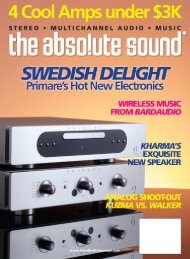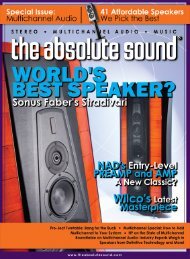Contents
Contents
Contents
You also want an ePaper? Increase the reach of your titles
YUMPU automatically turns print PDFs into web optimized ePapers that Google loves.
HP’s<br />
WORKSHOP<br />
HP’s Editor’s Choice Awards<br />
Speaker Systems<br />
The Nola Grand Reference Mk IV<br />
$140,000 (standard finish)<br />
nolaloudspeakers.com<br />
This “statement” design, by Carl Marchisotto, former protégé of Jon<br />
Dahlquist, had been evolving in ways that are refinements of the original<br />
design, rather than any radical rethinking of the four-tower system. (The<br />
two front towers do most of the work, since they contain the four-per-side<br />
midbass drivers, the six midrange units, and the nine Raven ribbon tweeters.)<br />
The latest change, however, is most striking, since Marchisotto scuttled all<br />
its midrange drivers, replacing them with slightly smaller but smoother and<br />
faster-sounding units. Oddly enough, the first thing we heard were sonic<br />
improvements outside the midrange: The highs from the ribbon tweeters<br />
sounded more open, airier, and a bit “sweeter” in the<br />
same way that the real thing sounds sweeter in the<br />
top octaves. Then we found the lows more focused,<br />
tighter, and much more of a whole cloth with the rest<br />
of the frequency spectrum. The two woofer towers,<br />
operating below 40Hz and consisting of four 12-inch<br />
ported drivers, had up until now been the Achilles heel<br />
of the handsome-to-behold and costly-to-own system.<br />
It occurred to me that maybe it was the upgrading of<br />
the crossover unit, also part of the Mk IV redesign,<br />
that might have made that critical difference at the<br />
frequency extremes, since Marchisotto has radically<br />
improved the capacitors in the external (and now much<br />
larger) crossover chassis and used Nordost wiring (and<br />
banana plugs) throughout. Marchisotto says he is now<br />
using capacitors in the entirely redesigned and enlarged<br />
crossover that are rated at 1200 volts DC (tolerance of<br />
one percent), monsters that are four inches long with<br />
a two-inch diameter. All the internal wiring is Nordost<br />
Valhalla, which is superb in delivering rock-solid lows.<br />
Even so, you’ll not get the best out of the woofs unless<br />
you sock it to them with plenty of power. That has meant, in our case,<br />
using a second ASR Emitter II to provide a well-nigh-perfect match and<br />
big thrills for the kick-ass-bass crowd, among whose number I sometimes<br />
find myself. With this system, as currently constituted, if the information<br />
is on the disc (be it CD or LP), you will hear it, and hear it as an inherent,<br />
continuously flowing part of the original, rather than with the kind of<br />
imposed definition that some call “hi-fi.” There maybe other “statement”<br />
speakers that have the authority of these speakers, but none will surpass<br />
the Nola’s ability to give you an uncanny sense of being in the space with<br />
the performers.<br />
The Magnepan MG 20.1 hybrid ribbon/planar<br />
system<br />
$12,500<br />
magnepan.com<br />
Dollar for dollar, these top-of-the-line Maggies represent the “best buy”<br />
in high-end audio. They have some critical advantages over much of their<br />
competition. The system consists of designer Jim Winey’s fabled true ribbon<br />
tweeter, and lower down, his much improved planar panels for the midrange<br />
and the bass. Because the speaker’s elements are free-standing panels, the<br />
Maggies need no enclosure, so you’ll never hear the sound of a “box,” one<br />
of the most pernicious colorations in audio. Since they also operate in dipolar<br />
fashion (the sound emanating from the panels, front and rear), the 20.ls have<br />
an inherent technical and acoustic advantage: They, like almost all dipolars,<br />
cancel out certain low-frequency resonant nodes. The absence of all these<br />
colorations gives the Maggies a freedom from aural strain that is not only<br />
refreshing, but to these ears, a closer replica of the sound of music itself.<br />
In this regard, they are just about unique in the field of high-end speaker<br />
systems. The drivers are fast—not electrostatically fast in the artificial and<br />
thin sense. So fast, that the initial attack takes precedence over its somewhat<br />
awkward rendering of decay-tails lower down in the spectrum. The biggest<br />
disadvantage here, for lovers of power music, is the<br />
tendency of the bass panels to “flap” when faced with<br />
great big low-frequency pulses at fortissimo levels. You<br />
may also want to watch out for this if you’re considering<br />
using the Maggies in a movie-oriented multichannel<br />
system. It will be inevitable that you’ll blow the fuses<br />
on the tweeters if you try to replicate theater sound<br />
levels (beware the DVD of Master and Commander),<br />
and, if you keep on pushing it, you may even fry the<br />
tweets. (They are easily replaced.) The advantage of the<br />
Maggies in such a system, however, is the extremely<br />
clear articulation it gives to dialogue and vocals. Also<br />
keep in mind that when the .1 channel is handled by<br />
subs (ours are four Thunderbolt IIIs from Nola), the<br />
Maggies won’t be aflappin’.<br />
These speakers are not high in sensitivity, and they<br />
do require a hefty amount of power. Winey designed<br />
them to be particularly forgiving of some of the<br />
transgressions of transistorized equipment (gear that<br />
usually has the power). And there are, if you’re going<br />
for these in a two-channel system, audible, though most<br />
minor, discontinuities in character between the ribbon and both the midbass<br />
and low-bass panel. But the 20.1s sound virtually seamless, so striking is their<br />
overall coherency, when compared with the big building-block speakers<br />
out there these days (you know the ones I mean, with boxes atop boxes).<br />
Remember I said “virtually.” If it’s truth to the music that’s your passion, this<br />
is the speaker you ought to start with.<br />
The Marten Coltrane system<br />
$50,000<br />
martendesign.com<br />
[Review to come.] Talk about a seductive sound system, this Scandinavian<br />
hybrid design is so mightily enchanting that it just about disarms the seriousminded<br />
or perfectionist critic. The stratospheric top octaves are handled by<br />
a “diamond” tweeter that, it is said, extends all the way out past 100kHz.<br />
Sure sounds like it, too. The other two drivers that handle the rest of the<br />
spectrum are ceramics—the first such I’ve heard in a setup of my devising<br />
(translated, that means here in Sea Cliff, carefully positioned in Room 2). The<br />
120 October 2006 The Absolute Sound










